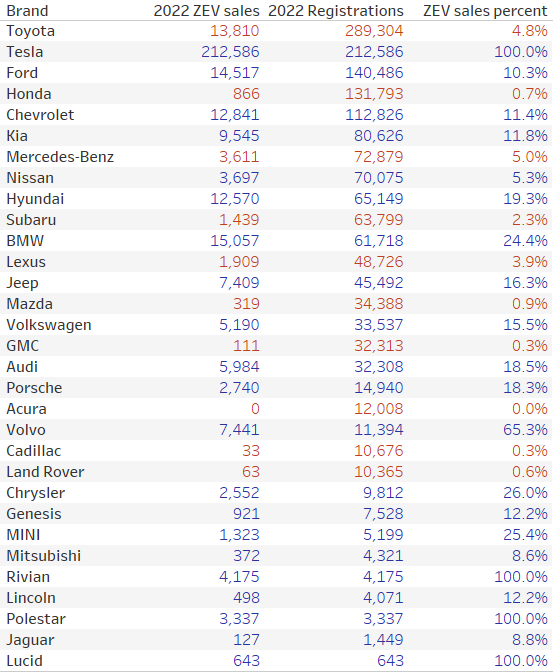Sales of new zero-emission vehicles (ZEVs) in California hit new highs in the first quarter of 2023.
According to the California Energy Commission, more than one in five of all new passenger cars and trucks sold in the state at the start of this year was a zero-emission vehicle, which includes plug-in hybrids, battery electric, or fuel cell electric vehicles. More than 16 percent of new cars sold this year are fully electric plug-ins. These sales statistics build on last year’s strong EV sales when the statewide average was 19 percent ZEV sales.
To date, more than 1.5 million ZEVs have been sold in California.

Sales in the Bay Area lead the way
EVs are popular new cars in both Southern and Northern California, but the highest sales in the state are in the San Francisco-Oakland Bay Area.
In the first three months of 2023, more than 30% of all new car sales were ZEVs in Alameda, Santa Clara, Marin, and San Mateo counties. These four counties have a significant population of about 4.5 million people, more than the population of 23 states.
Alameda County (home of UCS’s Western States Office in Oakland!) led the way with ZEVs making up 38% of new car registrations. With numbers like that, Alameda County is poised to be the first in state to have new EVs outnumber new gasoline cars.
EV sales are high despite some manufacturers lagging
Sales of new EVs in 2022 in California reached nearly 20% of new car sales despite the lackluster or non-existent ZEV offerings from some of the major automakers. Ten major auto brands, including Toyota and Honda, had 5% or less ZEV sales last year. Together, these brands with low ZEV sales sold more than 700,000 passenger cars and trucks in California. If they had reached even 10% ZEV sales, nearly 50,000 more ZEVs (and 50,000 fewer gasoline cars) would have been on the road last year.
For these brands, the low sales are directly tied to unavailability of ZEV models for prospective buyers. Honda (and its luxury brand Acura) currently does not offer a ZEV model in California. Toyota is offering some ZEV models, though they are in limited supply and the company has had a troubled rollout of their newest battery-electric offering. While recently the company has been more open to a ZEV future, their current offerings reflect a history of fighting against clean car rules.
Because of California’s Advanced Clean Cars II regulation adopted last fall, all automakers will have to achieve ZEV sales above 30% by model year 2026 and be on the way to 100% ZEV sales by 2035. Many companies are on the right path, but automakers that have been delaying the transition to ZEVs will have to make up for lost time by rapidly accelerating their ZEV product offerings over the coming few years.

Strong regulations are needed to ensure all automakers rapidly switch to ZEVs
Strong regulations, both in California and at the federal level, are important to ensure that all automakers transition from gasoline engines to electric motors as quickly as possible. It’s vital that this transition happens rapidly, both to reduce the amount of harmful air pollution and to limit damaging climate change. Transportation is the largest sector contributing to human-caused global warming emissions and passenger cars, trucks, and SUVs are the largest source of emissions within transportation, so switching to ZEVs is necessary.
While many of the major automakers have stated plans to shift to ZEVs both in the US and abroad, some companies are failing to make ZEV options available in significant volume. Regulations like the Advanced Clean Cars II rules adopted last fall in California are critical to ensure that all automakers move as quickly as possible and to enable new car buyers to have many ZEV options available when shopping for a new vehicle.
The US EPA’s recently proposed vehicle regulations will bring more efficient gasoline and zero-emission vehicle choices to buyers across the US. The new federal standards will mean about 60% of new cars sold in the US in 2030 will be zero-emission vehicles and about two-thirds will be by 2032. Recent survey results point to strong demand for electric cars and trucks and rules, like the new EPA standards, will ensure that the supply of ZEVs increases as well.

